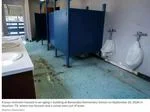Voters decisively rejected Houston ISD’s request to approve $4.4 billion in bonds to rebuild and renovate some of its facilities. The proposal was the largest bond proposal in the state’s history.
For many years, it was unusual for voters to give the thumbs down to bonds for public schools. That trend began unwinding a few years ago, as taxpayers began to recoil from proposals that included lavish athletic facilities in particular. Also, a new Texas law in 2021, which required school districts to state that approving the bond would result in a tax increase, put a damper on new proposals. Nonetheless, a study done by the Texas Tribune found that in recent years, 70-80% of school bond proposals were approved by voters. But in most cases, even when bonds were rejected by the voters, the vote was close.
But not so in HISD’s case. The final vote was 58-42 against. I could not find definitive statistics, but I suspect this is one of the worst school bond defeats in the State’s history. So, why did voters so soundly reject this proposal?
I think there were two factors.
First, rightly or not, for many the election became a referendum on Mike Miles’ leadership of the District. It is clear that Miles is wildly unpopular. His accomplishments in raising test scores in historically low performing schools have been swamped by his imperious, tone-death leadership style, which has managed to offend almost everyone. One of his worst blunders in my estimation has been the personnel shake-ups in schools that were performing well. He has repeatedly broken the old adage - “if it’s not broke, don’t fix it.”

But beyond the Miles factor, the bond proposal was ill-conceived. There is no doubt that many of HISD’s schools are decrepit and badly in need of repair and renovation as was dramatically laid out in this Houston Chronicle story. But this proposal went far beyond that kind of triage.

Those laying out this proposal seemed to be oblivious to HISD’s declining enrollment. In the last decade, the District’s enrollment has dropped from about 220,000 to under 180,000. HISD’s own projections are that it will fall by about another 10,000 over the next few years. That loss of enrollment is costing the district about $400 million annually in lost student allotments from the State. Also, apparently there was no consideration given to what effect voucher/school choice may have when it inevitably passes in the upcoming Legislature.
At least some of recent decline is likely the result of the state takeover and Miles’ controversial administration of the District. But far more consequential, especially in the long term, is that the District’s population has stalled and is likely to drift lower. There has been little change in the population inside Loop 610, which makes up a large portion of HISD, for the last sixty years. Also, the U.S. birth hit a new low last year of 1.67. That means that, unless people suddenly decide to return to Houston's core or start having larger families, every generation of school-age children in HISD from now on will be smaller than the one before it.
This demographic reality is what made me scratch my head over the bond proposal’s inclusion of about $2.1 billion to completely rebuild thirteen elementary schools and eight middle schools. The coming demographic decline will first begin reducing enrollment in elementary schools, with middle schools not far behind.
The thirteen elementary schools that were to be rebuilt are currently at 108% of the design capacity. However, all of the excess enrollment was accounted for in just two schools, Bonham and McNamara. In six, the current enrollment is already below the design capacity. The enrollment in the eight middle schools to be rebuilt is only 86% of their design capacity. Only two are currently operating above their design capacity. But here’s the real kicker, HISD is already projecting that the enrollment of twenty-one schools is going to decline by the 2028-2029 school year!
Building a school is a long-term investment, typically 50 years or longer. Given the demographic trends, what do you think the enrollment of HISD will be in 50 years? How many elementary schools will the District need in 2075? The reality is that HISD is in decline demographically and its plan for the future should focus on how to best manage that decline.
The logical thing for the district to do at this point would be to come back to the voters with a dramatically reduced bond proposal that focuses exclusively on the immediate needs. Ideally, the District also should develop a plan to begin reducing the number of schools. I know that closing schools is unpopular but that is the District's new reality.
However, the real conundrum for HISD is that even if comes back to the voters with a downsized plan, I am not sure any plan can be passed as long as Miles is in charge.1 While I agree that Miles’ accomplishments in raising test scores have been underappreciated, his personal style has become a serious distraction for the District and is now impeding the very reforms his supporters so desperately want. I am not sure HISD can pull out of its current tailspin with Miles in charge.
____________________________________________
Note 1 – I have some experience in HISD bond elections. I co-chaired and managed the HISD’s last bond campaign in 2012, which passed with 60% voter approval.

